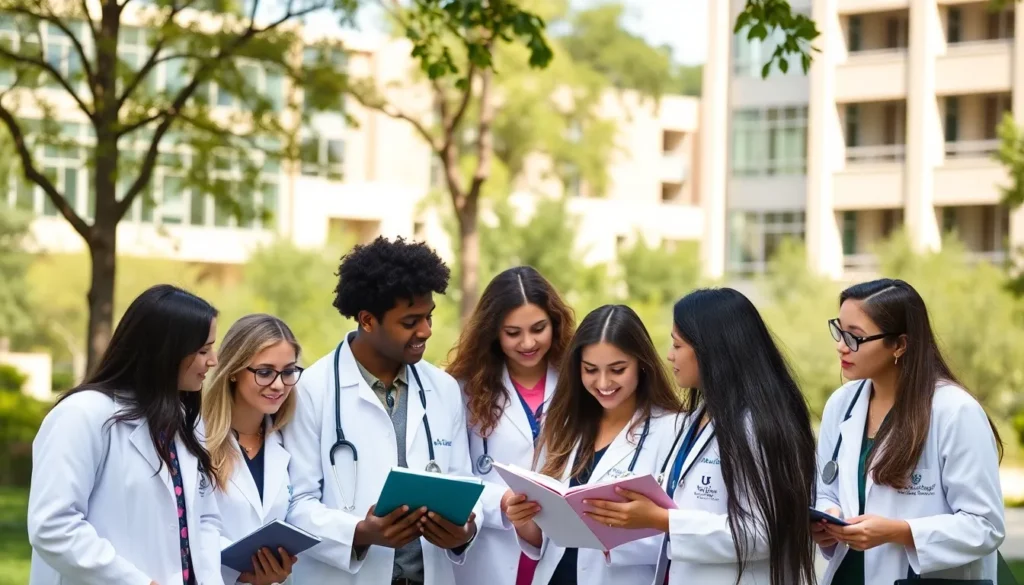Getting into medical school is like trying to find a needle in a haystack—except the haystack is on fire and the needle is wearing a lab coat. For aspiring doctors, UC Davis Medical School stands out as a beacon of hope, but just how tough is it to get in? With its reputation for excellence and a commitment to training compassionate healthcare professionals, the acceptance rate at UC Davis is a hot topic among pre-med students.
Understanding the acceptance rate can help applicants strategize their approach. It’s not just about grades and test scores; it’s about standing out in a sea of overachievers. So, buckle up as we dive into the numbers, explore what makes UC Davis a unique choice, and uncover tips to boost those chances of donning that coveted white coat.
Table of Contents
ToggleOverview of UC Davis Medical School
UC Davis Medical School, officially known as the UC Davis School of Medicine, stands out for its commitment to the principles of diversity, equity, and inclusion. The institution fosters a learning environment that promotes innovative medical education and a robust research culture. Each year, it attracts a diverse pool of applicants, creating a competitive selection process.
Aspiring medical students often seek information about the school’s acceptance rate. In recent years, this rate has hovered around 2-3%, reflecting the high level of competition among applicants. Only approximately 150 students gain acceptance from over 6,000 applications, making the process deeply selective.
Unique programs offered at UC Davis further enhance its appeal. The school emphasizes community engagement, primary care, and addressing health disparities, aligning its curriculum with societal needs. Resources such as the Center for Health and Technology prepare students to excel in a rapidly evolving healthcare landscape.
In addition, students benefit from extensive clinical training opportunities through partnerships with local hospitals and healthcare organizations. These hands-on experiences in various medical specializations equip graduates with vital skills and knowledge.
Understanding the holistic review process remains essential for prospective students. This review takes into account academic metrics, letters of recommendation, personal statements, and relevant experiences. Candidates who demonstrate strong leadership qualities, community service, or research involvement often stand out in a competitive landscape.
Ultimately, understanding UC Davis Medical School’s offerings and its acceptance dynamics can help prospective students better navigate the application process. It is critical for applicants to articulate their unique experiences and aspirations, setting themselves apart in this highly competitive environment.
Acceptance Rate Trends

Understanding acceptance rate trends helps prospective applicants gauge their chances of admission to UC Davis Medical School. Historical and recent statistics provide valuable insights into the program’s selectivity and competitiveness.
Historical Data
Data from previous years shows a consistent trend in acceptance rates at UC Davis Medical School. The acceptance rate has fluctuated between 2% and 3% over the last five years. For example, in 2019, the acceptance rate reached approximately 3%, with about 150 students admitted from over 6,000 applications. This historical context highlights a challenging admissions landscape where applicants must stand out in an increasingly competitive pool.
Recent Statistics
Recent acceptance statistics indicate that UC Davis Medical School maintains its rigorous selection process. For 2023, the acceptance rate remained around 2.5%, reinforcing its high level of selectivity. Approximately 160 students received offers of admission from over 6,400 applications. These recent figures emphasize the importance of a well-rounded application, showcasing academic excellence alongside personal and professional achievements.
Factors Influencing Acceptance Rate
UC Davis Medical School’s acceptance rate faces numerous influences. Academic performance ranks as a top factor. High GPAs and competitive MCAT scores often serve as basic criteria for applicants. Generally, successful candidates possess GPAs above 3.6 and MCAT scores typically above 510.
Extracurricular activities also play a significant role in the admissions process. Participation in research projects, community service, and leadership roles enhances an application. Candidates exhibiting meaningful engagement in healthcare-related environments stand out. Such experiences showcase passion and commitment to medicine.
Personal statements and interviews further affect acceptance outcomes. A compelling personal statement should effectively convey unique motivations for pursuing medicine. Crafting a narrative that highlights personal experiences engages admissions committees. Interviews provide candidates a platform to demonstrate communication skills and interpersonal qualities. Strong performance in these areas can sway admissions decisions considerably.
Comparison with Other Medical Schools
UC Davis Medical School’s acceptance rate of around 2-3% demonstrates a competitive landscape in comparison to other institutions. For instance, Harvard Medical School typically has an acceptance rate of 3.5%, while Stanford University School of Medicine hovers around 2.2%. Both schools attract a large number of applications, similar to UC Davis, yet the selectivity varies slightly.
At the University of California, San Francisco (UCSF), the acceptance rate stands at about 3%, closely aligning with UC Davis. Such figures indicate that many candidates face fierce competition not only at UC Davis but also at other prestigious medical schools across the nation.
Considering the rigorous admission standards, academic performance remains essential. Candidates often need GPAs above 3.6 alongside competitive MCAT scores, typically above 510, to remain in contention at these esteemed institutions. However, UC Davis emphasizes holistic review processes, where factors like community service, leadership, and research impact admissions significantly.
Focusing on involvement and unique experiences often proves vital. For example, candidates presenting strong personal statements and performing well in interviews can enhance their chances dramatically. This holistic approach sets UC Davis apart from some other medical schools that might prioritize test scores more heavily.
Notably, fluctuations in acceptance rates at UC Davis mirror trends seen at peer institutions. In 2019, the acceptance rate reached approximately 3%, while it dropped to around 2.5% in 2023. Such changes reflect the evolving nature of competitive admissions, where prospective students must continuously adapt to stand out in a crowded field.
Strategies for Applicants
Applicants targeting UC Davis Medical School should focus on several core strategies to enhance their chances of acceptance. Prioritizing academic excellence remains essential; maintaining a GPA above 3.6 serves as a strong foundation. Securing a competitive MCAT score of 510 or higher continues to significantly bolster an application.
Showcasing leadership and community service experience stands out in the holistic review process. Engagement in research projects or volunteering with underserved populations not only demonstrates commitment but also enriches candidates’ profiles. Identifying unique experiences or challenges can set an applicant apart, offering insights into their resilience and dedication.
Personal statements should convey authentic motivations for pursuing medicine, emphasizing personal growth and aspirations. Demonstrating a clear understanding of UC Davis’s values in diversity and community engagement reveals a strong fit for the program.
Preparing thoroughly for interviews remains crucial as well; practicing common questions and articulating specific reasons for choosing UC Davis strengthens responses. Being familiar with the school’s innovative programs, particularly those focused on primary care and health disparities, can showcase genuine interest and alignment with its mission.
Additionally, obtaining strong letters of recommendation adds credibility. Select recommenders who can provide detailed insights into the applicant’s capabilities and character. Building a network of mentors who understand the application landscape can also offer invaluable guidance.
Finally, staying informed about trends in acceptance rates and adapting strategies accordingly aids in navigating the competitive process effectively. By implementing these strategies, candidates can enhance their applications and stand a better chance in the selective admissions landscape of UC Davis Medical School.
Navigating the admissions process for UC Davis Medical School requires a strategic approach. With an acceptance rate of around 2-3% applicants must present a well-rounded profile that highlights both academic achievements and personal experiences. The school’s commitment to diversity and community engagement further emphasizes the importance of demonstrating a genuine passion for medicine.
By understanding the competitive landscape and focusing on key factors such as GPA MCAT scores and extracurricular involvement candidates can enhance their chances of acceptance. Tailoring personal statements and preparing thoroughly for interviews are also vital steps in making a lasting impression.
For those aspiring to join UC Davis Medical School the journey may be challenging but with dedication and preparation it’s possible to stand out in this highly selective environment.








